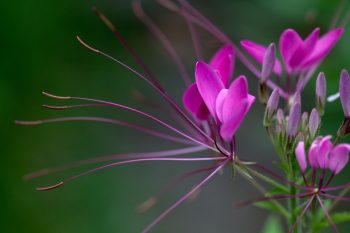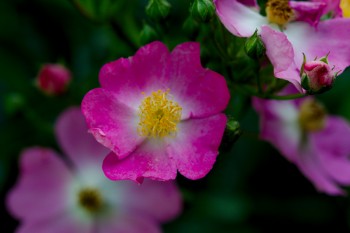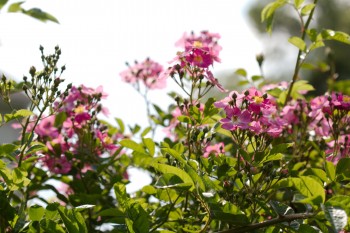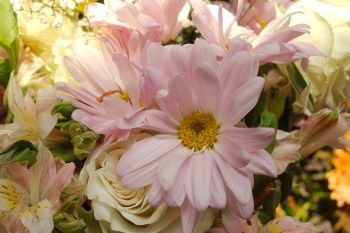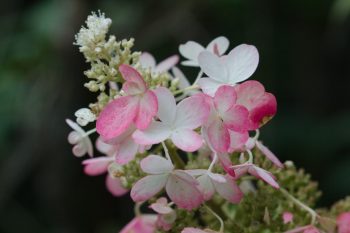I’m not a big fan of hyacinths in general. They’re pretty enough but they smell quite awful. Some people like it, I guess but it’s too much for me. Anyway, they are pretty cheery in the garden.
Tagged With: Pink
Camellia japonica ‘Pink Perfection’
Most of the camellias in my mom’s yard have been touched by the cold weather we’ve had lately. This bush is absolutely covered with formerly perfect pink blossoms but now most of them are touched around the edges with brown. Still, from a distance it’s an amazing sight.
Oh, and they make me think of my dad, which is also really nice.
Hyacinth
I thought I’d post another hyacinth photo, now that they are fully open. Julia, this one’s for you.
Flowering Almond
We planted this flowering almond when we first moved into the house. It was given to Cathy by a friend. It never gets more than about three feet tall and dies back almost to the ground every other year. Still, when it’s in bloom, it’s pretty nice. And it doesn’t need any pruning.
Rose ‘Roseraie De l’Hay’
This is a nice rugosa hybrid that booms all summer long. The flowers have an intense clove scent that I really love. The only downside is that the shrub is so tall and most of the roses are on the top so you usually see them from below. Still, it will have a lot of blooms shortly and will be something to see.
A Pink Multiflora Rose
Normally I’d be the last person to suggest that anyone grow a multiflora rose. About them the great plantsman Michael Dirr says, “use this species with the knowledge that none of your gardening friends in the immediate vicinity will ever speak to you again.”
Still, when I came across a bright pink multiflora — it is almost certainly a natural hybrid but it is a multiflora in every way except petal color — I decided I had to have it. I dug up a small piece and it’s thriving on my back fence. The parent plant was destroyed, so I got it just in time.
It’s really a lovely shrub and it is absolutely covered with hundreds of flowers and thousands of buds. Just don’t tell Spencer.
‘Perle d’Or’
Next to our front door is this sweet little China rose, ‘Perle d’Or’ (Joseph Rambaux/Rambaud, France, 1884). It’s just about through with it’s first main flush but it will have at least a few flowers on it from now until the first frost. A wonderful scent, as well.
‘New Dawn’
On August 31, 1931, the U. S. Patent Office granted plant patent number 1 to Henry Bosenberg for the rose ‘New Dawn’. There’s a lot to like about this rose but not least is that it so reliably reblooms and it has such beautiful, shiny green foliage that doesn’t have problems with black spot, even here in Maryland. I got my plant from my coworker, Kamala and it’s growing up and over the back fence. This brings “rose week” to a close as this is the last of the nine roses in our garden.
Cleome hassleriana
Commonly known as spider flower, Cleome hassleriana is a really nice plant. It’s probably just as well that it’s an annual or it might get out of hand. This is its first bloom of the summer in our yard and it should continue until early fall.
Multiflora Rose
Last year in my Project 365 I posted a picture of this rose on Day 142, May 22, 2011. I know that you have to be a bit daft to actually plant a multiflora rose, particularly in a small garden. The great English rosarian, Graham Stuart Thomas, says in The Graham Stuart Thomas Rose Book (Sagapress, 1994):
It can best be described as an arching shrub, although its shoots will ramble into trees as high as 20 feet. Normally it makes a dense thicket of interlacing lax shoots, much like a blackberry. So dense is it, indeed, that when planted closely as a hedge it is rabbit-proof, and so thickly do its stems grow that it is becoming increasingly popular in the United States and also in Britain as a roadside plant, for its resilient thicket can hold a car which runs off the road. What a use for a rose! On the other hand, how lucky we are to be able to provide so pretty and sweet a shrub for such a use. It is claimed in America that it is “horse high, bull strong and goat tight.
Thomas, of course, was a rose person. How bad can any rose be? On the other hand, Michael A. Dirr is a more general horticulturalist. He has a little different opinion of R. multiflora in his well respected, 1,187 page Manual of Woody Landscape Plants (Fifth Edition, Stipes Publishing, 1998).
Under the heading “Habit” he says, “A fountain with long, slender, recurving branches; eventually forming an impenetrable tangle of brush suitable only for burning.” About its growth rate he says, “fast; too fast for most farmers who have this species in their fields.” His description for “Culture” is, “Same as described under R. rugosa although this species is more invasive; tolerates dry heavy soils very well.”
He goes on with an entry for “Landscape Value” of “None in the residential landscape; has received a lot of attention for conservation purposes; makes a good place for all the ‘critters’ to hide, yet can be a real nuisance for the birds deposit the seeds in fence rows and open areas, and soon one has a jungle; use this species with the knowledge that none of your gardening friends in the immediate vicinity will ever speak to you again.” Finally, he gives the following “Additional Notes.” “Utilized as an understock for budding the highly domesticated selections. Another species that appears resistant to black-spot and the typical rose diseases. I cannot overemphasize the invasive and greedy nature of this species. Have observed entire pastures/fields invaded and captured by the plant.”
Having said all that, I’m a fan of places for all the critters to hide. Also, this pink sport or more likely a natural hybrid, was growing at the edge of the woods near my office. I dug up a small piece and within a month all that was growing there had been sprayed and killed. Some would argue that I should have let it all be killed but this pink version, which is very similar in almost every way to the species, seemed worth keeping. The difference it in the flowers — they are larger than the species, as well as being a beautiful, dainty pink. There are somewhat fewer of them, but still enough. The leaves seem entirely free of rust, mildew, and black-spot.
Actually, my ultimate goal is to try to produce a tetraploid version of this diploid rose. That would be valuable for hybridizing, because some many important roses are tetraploid. Whether I can actually do that remains to be seen. In the meantime, I’ll continue to prune this hard, trying to keep it contained, and I’ll do it with the knowledge that none of my gardening friends in the immediate vicinity will ever speak to me again.
Pink Rosa multiflora
Another rose photo taken on Monday. Don’t worry, I’m almost out of roses. I posted a few pictures of this rose on May 12 last year along with a fairly lengthy description of R. multiflora. That should be enough of a description to keep anyone from planting this in their garden, but then, this pink version is a little special. Wouldn’t it be nice to get this pink color, along with the well known multiflora resistance to blackspot and incredible vigor, into a repeat flowering rose? That’s my ultimate goal. Not sure what to cross it with, at this point, but I’m thinking. I’d also like to try my hand at creating a tetraploid version of this rose and see what that looks like. Of course, I’ve been meaning to work on that for quite a few years. Some day…
Pink Multiflora Hybrid
The roses are really starting to bloom, finally. This is one that only blooms once during the year but it’s beautiful when it does. It also have very healthy, disease resistant foliage, so it looks pretty good the rest of the year, although it’s just green, of course. This is a found rose and seems to me to be mostly R. multiflora. The wonderful pink flowers, however, speak of some other genes in the mix. I think this rose might contribute to some interesting breeding work and for years I’ve considered it, but so far, haven’t actually done anything.
Rosa multiflora
It’s time for my annual photo of the Rosa multiflora hybrid I have in our back garden. This is a natural hybrid, found growing in the woods near my office. The parent plant is no longer there, because about a month after I dug up a piece it was sprayed and killed. Normally that’s the right thing to do with R. multiflora but this one is special to me, because of the pink blooms that cover the plant this time of year for about a week. It’s quite lovely. It would be even better, of course, if it repeated but one cannot have everything. It’s a vigorous plant, as one would expect with a multiflora hybrid, and handsome as a large patch of green on the back fence, even when not in bloom. It takes a bit of extra care, pruning and cutting out dead wood every couple years, but it’s well worth the effort. That effort is made more difficult by the quantity (large) and quality (also large and very sharp) thorns that absolutely cover the canes. Still, worth it.
Multiflora Buds In The Rain
The rain continued today but I went out briefly to take a few pictures. The large, pink Rosa multiflora (or mostly multiflora, anyway) shrub against our back fence is covered with buds and is just starting to come into bloom. In a few days, and certainly in less than a week, it will be covered with pink flowers. At this point there are only occasional flowers and lots and lots of buds. But in the rain, even that can be pretty, I think. It builds anticipation, if nothing else.
Rosa Multiflora
A few days ago this plant was a mass of buds in the rain. Now the rain has stopped and the buds are opening. Individually the flowers are not really all that amazing, five small, simple, pink petals around a bunch of yellow stamens. In mass they are quite impressive. The entire plant is turning from green to pink and will get pinker before it is done. I picked out one picture to post here and then second guessed myself. I found that I couldn’t decide which one I liked better so I’m posting them both.
Of course, like most rose species, this one only blooms once and then it’s done for the year. It also has very little fragrance. My dream is to cross this with roses that repeat and which have fragrance to get some of the multiflora vigor and disease resistance into a new group of hybrids. Whether that’s ever going to happen is anyone’s guess. Another project, even before crossing it with anything else, is an attempt to double the chromosomes. R. multiflora is, like many rose species, diploid (it has 14 chromosomes). Many hybrid garden roses, including most hybrid teas and floribundas and a lot of the roses I’d cross like to make crosses with, are tetraploid (28 chromosomes). For breeding purposes, a cross between a diploid and a tetraploid is problematic because it produces triploid offspring, which are, with notable exceptions, sterile.
Rosa multiflora
My pink multiflora rose is in full bloom. I suspect it isn’t 100% R. multiflora, because those have white flowers and this is clearly not white. What the rest of its genetic makeup is, I really couldn’t say. R. virginiana would be a reasonable guess. The color is right. The leaves are definitely R. multiflora and it’s got the requisite resistance to black spot. It’s possibly a bit less vigorous, but that’s probably something in its favor. R. multiflora will generally take over and this is large, but fairly well behaved. Pity it only blooms once, but then, the same can be said for the azaleas.
Lonicera sempervirens
Dorothy went to camp this morning so I gave Jonathan a ride to the farm. He plans to stay there for the week and Dorothy will pick him up on Friday. While I was there I took a few pictures of this trumpet honeysuckle (Lonicera sempervirens) growing on a post in front of their garage. This is a native honeysuckle to the southeastern United States. The flowers are not fragrant but are quite pretty, with scarlet to orangish red on the outside and yellowish inside. They are attractive to hummingbirds, butterflies and bees.
Flowers
This morning I took some pictures of a print that was left with us on Saturday for Tsai-Hong. It was made by one of Ralph’s caving friends who came to the memorial and it’s a somewhat impressionistic scene from a cave. But late this evening I realize I hadn’t taken any other pictures today and I didn’t want to post a picture of something that’s copyrighted as my photo of the day. In consequence, today’s picture is of some flowers that my mom got for the memorial and which have been on our dining room table since.
Sunset, Ocean Isle Beach
As many of you know, we were at the beach last week. I’m going to try to get caught up posting pictures so expect two per day for the next week. We had a relatively easy drive down on Saturday, covering the 420 or so miles in a little over 7.5 hours. It was drizzling when we left home, then south of Richmond we had mostly sunny skies. We had rain going around Wilmington, NC and it was cloudy and threatening after that. The sunset was pretty amazing, with the color from the sky turning the ocean an amazing color.
Hydrangea
This hydrangea has taken a few years to get established. Last year it was eaten back by the deer, which didn’t do it a whole lot of good. We’ve managed to protect it (or have simply been lucky) this year and it’s doing much better. We planted it and another, blue hydrangea a few years ago but the other didn’t make it. This seems happy and the flowers, white and pink, are quite nice against the green of our back border. We’ll need to do a little pruning to keep the forsythia from covering it up, but I think it’s well on its way to being a favorite late summer bloomer.









